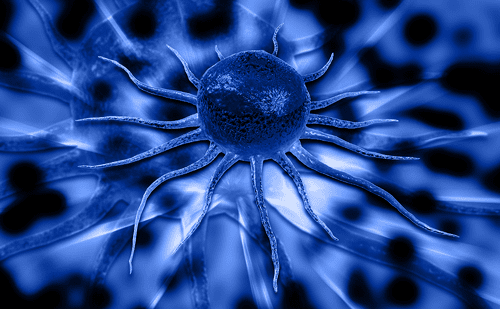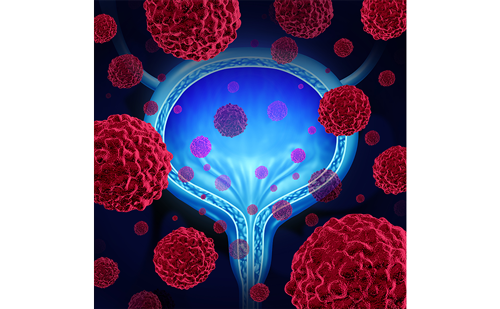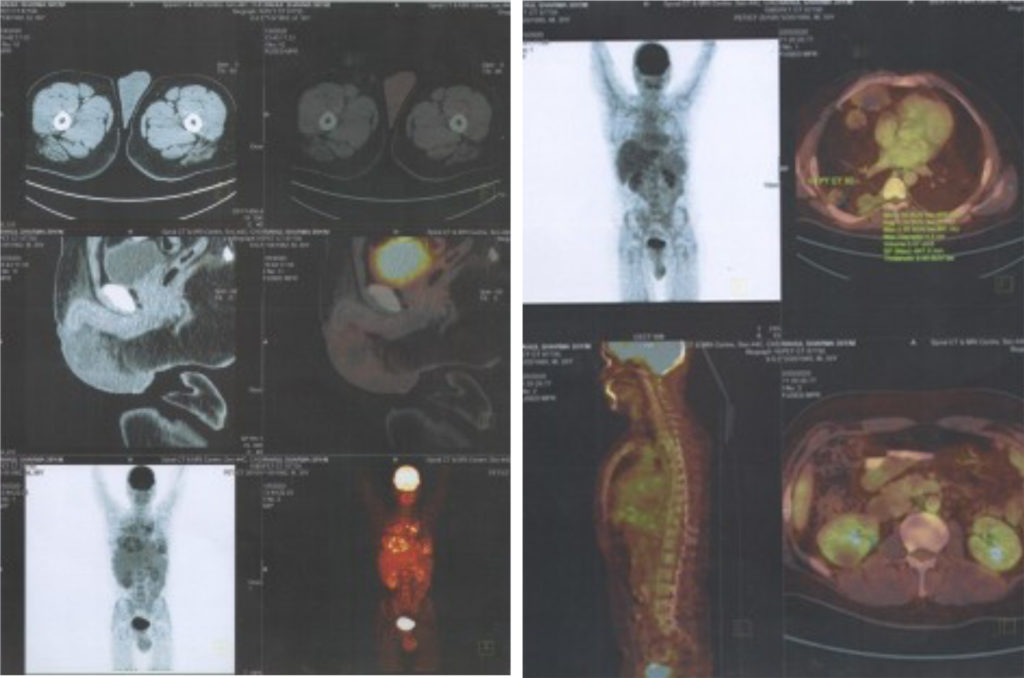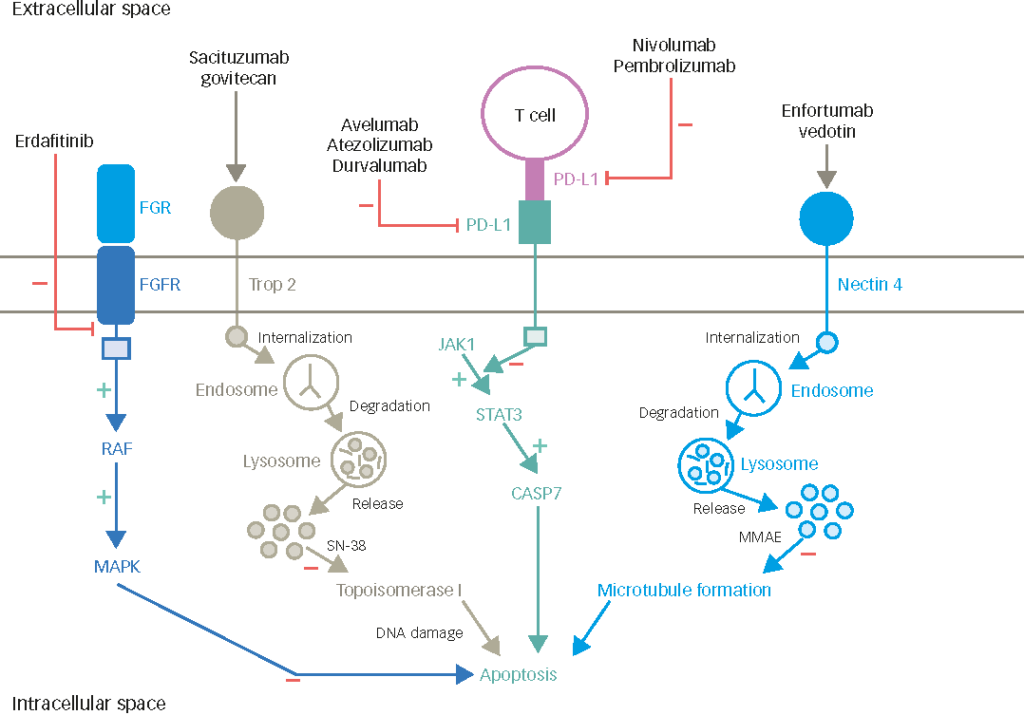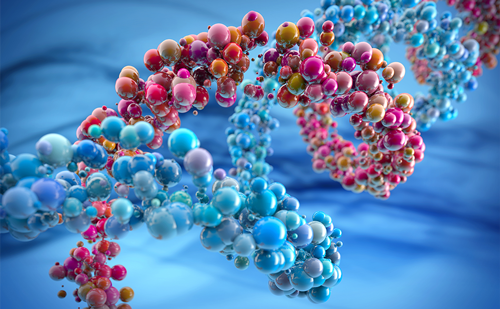Bladder Cancer Diagnostics and Onset of New Strategies
The diagnosis of bladder cancer is based on the information provided by cystoscopy, the gold standard, in combination with urinary cytology findings. The development of genomic markers is still a matter of research, the assays being time-consuming, expensive and difficult to standardise. Gene profiling could already be successfully applied to classify bladder tumours based on their progression and clinical outcome. Sanchez-Carbayo et al.1 performed gene discovery in bladder cancer progression using complementary DNA microarrays by comparing the expression profiles of early-stage and advanced bladder tumours, using cDNA microarrays containing 17,842 known genes and expressed sequence tags. As a result, cytokeratins 20, neuropilin-2, p21 and p33ING1 were selected among top-ranked molecular targets differentially expressed and validated by immunohistochemistry using tissue microarrays. Their expression patterns were significantly associated with pathological stage, tumour grade and altered retinoblastoma (RB) expression. The results of such research are a basis for development of new specific genomic and proteomic bladder cancer assays. The results and applications of genomics and proteomics can be regarded as complementary and do not exclude each other. At present, proteomics-derived biomarkers can already be applied in the daily practice of the urologist. The term ‘proteome’ has been adopted to specifically describe the unique complement of proteins that reside in a cell. A new class of markers and assays has been developed within this area and some have already been successfully clinically investigated in larger studies.
Proteomic Profiling for the Detection of Cancer – General Aspects and Techniques
Proteomics is an increasingly powerful and indispensable technology in molecular cell biology. The key, but little understood, technology in mass spectrometry (MS)-based proteomics is peptide sequencing, which has recently been described and reviewed in an easily accessible format.2 Two- dimensional (2-D) gel electrophoresis is conventionally used as a first step to separate and isolate the proteins based on size (mass) and isoelectric point (pH gradient), resulting in many protein spots. Identification of proteins present or absent from tumour tissue, compared with tissue from normal or benign disease tissues, may allow the detection of tumour-specific proteins. Gel electrophoresis techniques are suited for combination with technologies such as laser capture microdissection (LCM) and highly sensitive MS. These methods are currently being used together to identify greater numbers of lower abundance proteins that are differentially expressed between defined cell populations. Additionally, surface-enhanced laser desorption/ionisation time-of-flight (SELDI-TOF) analysis enables the high-throughput characterisation of lysates from very few tumour cells or body fluids and may be best suited for the diagnosis and monitoring of disease. SELDI is an affinity-based mass spectrometric method in which proteins of interest are selectively absorbed into a chemically modified surface on a biochip. The commercial SELDI system is based on ready-made arrays of addressable binding sites on multisample strips. These ProteinChip® arrays are available with different chemically defined surfaces that permit protein binding based on hydrophilic, ionic or hydrophobic interactions or on affinity for metal chelates, so that a range of protein classes may be identified in a relatively simple screening strategy. In SELDI-TOF-MS analysis, a nitrogen laser desorbs the protein/energy-absorbing molecule mixture from the ProteinChip array surface, enabling the detection of the proteins captured by the array. Once captured on the SELDI protein chip array, proteins are detected by TOF MS.
Results of the Proteomics Approach for Bladder Cancer Biomarker Detection
Recently, two approaches in proteomics have led to a progression in early bladder cancer detection. These include staining of tissues by immunowalking and new assays derived from SELDI-TOF-MS analysis for detection of nuclear matrix proteins (NMPs) in urinary samples.
Immunowalking – Identification of Pre-malignant Lesions
This is an approach described by Celis et al.3,4 Immunowalking means walking from a morphol- ogically normal-looking urothelium towards the tumour. Because bladder cancer is a field disease, and a large part of the urothelium is at risk of developing disease by being in contact with carcinogens present in the urine, the Celis Group surmised that cystectomy specimens from patients with invasive disease might exhibit a wide spectrum of abnormalities ranging from early metaplastic stages to invasive disease. They looked for squamous cell carcinomas (SCCs) pre-cancerous lesions by carrying out a systematic analysis of the proteome expression profiles of fresh SCCs and ‘normal’ urothelial tissue from patients that have undergone removal of the bladder (cystectomy), due to invasive disease. Briefly, fresh normal random biopsies and tumour biopsies of various grades and stages were labelled for 14 hours with 35S-methionine and the proteins were separated by 2-D gel electrophoresis. Following autoradiography, protein profiles were compared, to identify interesting expression changes – the individual proteins are further characterised by MS.
These studies were complemented by comprehensive gel-based protein databases that display qualitative and quantitative information on proteins. Firstly, they identified proteins that are differentially expressed by pure SCCs and ‘normal’ urothelium using gel-based proteomics in combination with mass spectrometry – thereafter, they used specific antibodies against the putative markers to stain serial cryostat sections from bladder cystectomies of SCC-bearing patients. The analysis of cystectomies from several SCC-bearing patients has so far revealed at least three types of metaplastic lesions that can be readily differentiated based on the staining with antibodies against keratin 19. Type 1 metaplasias express keratin 19 in all cell layers, just as normal urothelium and show variable, but weak, expression of keratin 14 depending on the intensity of the keratin 19 staining of the basal cells.
Type 2 lesions express keratins 19 and 14 in the basal cell compartment, while type 3 lesions are character- ised by lack of expression of keratin 19 and by the basal and supra basal expression of keratin 14. Celis et al.
concluded that these lesions may be considered a direct precursor to the tumour. As additional markers become available it will be possible to accurately define the phenotype of pre-cancerous lesions and specific membrane markers, or secreted proteins derived from these lesions, may provide potential biomarkers for early diagnosis using urine samples.14
SELDI-TOF-MS – Nuclear Matrix Proteins
The efficacy of the SELDI-TOF-MS technology for the discovery of cancer protein markers in serum has successfully been demonstrated for the detection of different nuclear matrix proteins (NMPs). NMPs are involved in the control and co-ordination of gene expression. NMPs as tumour markers in different tumour entities have recently been reviewed.5 In bladder cancer, BCLA-4 and NMP22 are two NMPs released into the urine by tumour cells.
Expression of BLCA-4 (a tumour marker for bladder cancer), the cDNA of which reveals that it is a novel member of the Ets-transcription factor family, is not found in benign urologic conditions. Overexpression leads to increased growth rates of cells and the protein interacts with other transcription factors. BLCA-4 is a bladder cancer marker that is highly specific and occurs early in the development of the disease. It appears to be a transcription factor that may play a role in the regulation of the gene expression in bladder cancer. Urinary BLCA-4 determination appears to have high potential as a test for screening and monitoring bladder cancer in the general population and in groups at high risk from the disease, such as those with spinal cord injury.6,7 According to large clinical studies, the quantitative NMP22 assay is at least twice as sensitive as cytology in detecting early-stage cancers and up to 90% sensitive and 99% specific. In a study of Poulakis,8 involving 739 patients suspected of having bladder cancer, for histological grades 1 to 3, the sensitivity in detecting transitional cell carcinoma was 82%, 89% and 94% for NMP22 and 38%, 68% and 90% for voided urinary cytology, respectively. The investigations of Ponsky et al.9 in a total of 608 patients, taking certain exclusion criteria, found that specificity and positive predictive value (PPV) of NMP22 was 99.2% and 92.0% respectively, similar to urinary cytology (99.8% and 94.1%).
A highlight in the present development of nuclear matrix assays for cancer detection in risk groups is the easy-to-handle qualitative point of care (POC) assay NMP22® BladderChek®. This qualitative assay is a 30-minute chromatographic analysis of four drops of freshly voided urine, with antigen detection by anti-NMP22 antibodies. The assay was released in 2002 and has been admitted by the US Food and Drug Administration (FDA) as an aid in the monitoring and screening of urinary cancer. There are currently two other biomarker assays that were approved by the FDA for the monitoring of recurrent transitional cell cancer (TCC) following surgery, but this is the only approved biomarker assay for the diagnosis of de novo bladder cancer.
NMP22 BladderChek test in combination with cystoscopy improves the performance of cystoscopy.
At every stage of the disease, BladderChek provides a higher sensitivity for the detection of bladder cancer than cytology, which now represents the adjunctive standard of care. According to Tomera,10 BladderChek is up to four times more sensitive than cytology and is available at half the cost. Early detection of bladder cancer improves prognosis, quality of life and survival, which is why the NMP22 BladderChek may be analogous to the prostate-specific antigen test and eventually expand beyond the urologic setting into the primary care setting for the testing of high-risk patients characterised by smoking history, occupational exposures or age. As a urologist, the author believes that the NMP22 BladderChek test has an immediate and vital utility, because it is immediately available, has minimal cost and causes no patient discomfort.Further studies on the NMP22 BladderChek were presented at the 2004 meetings of the European Association of Urology (EAU haematuria patients) and at the American Urological Association ((AUA) follow-up in bladder cancer patients). These studies include a total of 418 patients. The test was used prior to endoscopy of patients with haematuria or patients with treated urinary bladder cancer during follow-up at 16 different urologic practitioners’ sites in Germany. Patients with urocystitis, stones, urinary tract infections (UTIs) and incorporated catheters were excluded. Positive results were verified by cystoscopy, including histology. Follow-ups with ultrasound and urography were included. In the case of NMP22 BladderChek, the sensitivity, specificity, positive predictive values (PPVs) and negative predictive values (NPVs) in the haematuria group (N=212) were 82%, 98%, 82%, 98% and in the follow-up group (N=206) 61%, 98%, 85% and 94%, respectively. In the subgroup of haematuria patients (14 with tumour and 99 free–free), NMP22 BladderChek had 86% sensitivity and 98% specificity compared with cytology that had 57% and 97%, respectively. There were no free–free patients for whom both tests were false-positive. Simultaneous diagnostics by NMP22 BladderChek and cytology were made in 252 cases, including haematuria and follow-up. In this investigation, cystoscopy was false- negative twice and false-positive twice. In only four cases (1.6%) both markers were false-negative. When both markers were positive, the final result was true positive in every case. The overall specificity of 98% and the NPV value of 98% in haematuria patients compared with cytology with 97% specificity makes the NMP22 BladderChek the superior choice in non-invasive diagnosis. In addition, combining NMP22 BladderChek and cytology can improve overall specificity in haematuria patients. The finding that no incidences in which both were false-positive in the 99 true negative cases is like a 100% exclusion criterion. When both markers are positive in a patient, the result appears to be a 100% inclusion criterion for cancer. The fact that cystoscopy was false in four out of 418 cases demonstrated the need for an accurate adjunctive test.
Conclusions
Urine cytology has so far been used routinely for the diagnosis and follow-up of malignant urothelial lesions and has long been relatively specific for bladder carcinomas (93%), but its sensitivity is only 27% for low-grade lesions and 77% for high-grade tumours.11,12 Cystoscopy on the other hand has high specificity but is invasive, expensive and sometimes inconclusive, particularly in cases of cystitis.
New classes of biomarkers derived from MS analysis of the low molecular weight proteome have shown improved abilities in the early detection of disease and, hence, in patient risk stratification and outcome. The development of a modular platform technology with sufficient flexibility and design abstractions allowing for concurrent experimentation, test and refinement will help speed the progress of mass spectroscopy-derived proteomic pattern-based diagnostics from the scientific laboratory not only to the to the medical clinic but also to the practising urologist.Results from the genomic studies of Sanchez- Carbayo13 and the proteomic studies from Celis give reason to assume that there will be a revival of cytokeratins as tumour markers in early detection of pre-cancerous conditions and early cancer as it had been reported for the cytokeratins 8, -18 and – 19, formerly described as the tumour marker tissue poly-peptide antigen (TPA) in urinary bladder cancer.14,15 What BladderChek accomplishes is improving the sensitivity of cystoscopy. While cystoscopy is macroscopic, NMP22 BladderChek provides a molecular view of the complete urinary tract. NMP22 BladderChek seems to be of high practical utility for the daily praxis of the urologist because it needs no laboratory equipment. Its practical meaning for bladder cancer prevention can be compared with that of prostate-specific antigen (PSA) in prostate cancer. Sensitivity, specificity, PPV and NPV of NMP22 BladderChek for bladder cancer are superior compared with those of PSA in prostate cancer. In addition, combining NMP22 BladderChek and cytology can improve overall specificity in haematuria and in follow-up patients.
According to the authors’ view and professional experience, the present limitations of the test seem to be the unawareness of the bladder cancer risk groups, of patients suffering from bladder cancer and barriers including low margins for the urologist, changing the standard cytology test to BladderChek and doctors possibly losing revenue to NMP22 BladderChek. These limitations will be overcome by objective information brought by independent media to the public and the consequent urgent personal demands of those persons who are either at risk or who are already suffering from bladder cancer. ■




